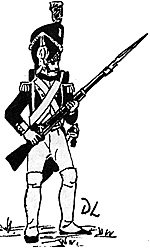 As far as I'm concerned, this is the true
"War in the East," a battalion/regimental level
simulation of the battle of Borodino in 1812.
Units represent battalions or regiments of
infantry, regiments of cavalry and companies of
artillery; the turns are 20 minutes long and the
hex scale 100 meters. The map consists of four
sheets, each 22"x 28", printed in blue, black, and
tan on cream paper. For those of you who have
SPI's Borodino, the La Bataille mapboard covers
virtually the same area but of course with a
much greater eye to detail.
As far as I'm concerned, this is the true
"War in the East," a battalion/regimental level
simulation of the battle of Borodino in 1812.
Units represent battalions or regiments of
infantry, regiments of cavalry and companies of
artillery; the turns are 20 minutes long and the
hex scale 100 meters. The map consists of four
sheets, each 22"x 28", printed in blue, black, and
tan on cream paper. For those of you who have
SPI's Borodino, the La Bataille mapboard covers
virtually the same area but of course with a
much greater eye to detail.
There are new villages, paths and hills on the board, and the Fleches are three seperate fortifications instead of one. The counters are beautifully printed, the French troops being white lettering on a blue background, and their foreign units a medley of colors, and the Russians being while lettering on a green background. The front of the counter has the unit's divisional and regimental numbers, its stacking points and movement factor; the back contains the fire and melee combat factors, the morale of the unit, its range, and other details, 5 OB sheets come with the 1330 counters to organize them on, 2 each of the combat tables and terrain charts and a turn record chart for each side. The physical quality of the game is high, except for the rules which are not bound but stapled together, but this is a minor detail. With the rules come a very comprehensive order of battle, and 1 and 1/4 pages of errata, none of it especially serious.
Play mechanics in La Bataille are simple and yet realistic. Turns are divided into 5 phases: the movement phase, rally phase, then the defensive fire phase, offensive fire phase, and offensive melee combat phase. Movement costs vary with the type of terrain and the kind of unit moving through it; the terrain also dictates the number of stacking points which a player can have in that particular hex.
During the rally phase leader units stacked with routing combat units attempt to rally them so that they may return to the fighting; various commanders are better at this than others. Units that can't be rallied keep running until they exit the board, whereupon they are lost. The two fire phases are just that, with the defender firing fisrt in an attempt to inflict casualties before his opponent can melee him. Then the attacker fires and follows that up with melee attacks, which are voluntary in ZOC.
Fire attacks are resolved by comparing the attacker's melee strength to the defender's melee strength. Leaders can add various combat bonuses to the attackers and defenders depending on their abilities, but they can also be killed or wounded. Seperate CRT's are used for fire and melee attacks. In addition to the usual 1/1, 2/1, 3/1 odds there are also 1/1.5, 1.5/1, 2.5/1 etc., which makes the combat situation more realistic. Losses are calculated in stacking points, with numbered markers indicating the current strength of weakened units.
There are six small scenarios (Shewardino, Utitsa, Morning Attack on the Raevski Redoubt, Uvarov's Diversion, Afternoon Attack on the Great Redoubt, The Bagration Fleches) and the big scenario which covers the entire third day. The designer has omitted the first two days as being militarily unproductive, and if one wants they can easily be reconstructed as all the units and terrain are available.
But the third day by itself is of necessity a multi-player game. In the multi-player game the commanders on the same side may not talk to each other but instead must send written messages via their aides. Not only can the messages be incomplete or confusing, but the aides can also get lost, thus delaying the message. Units assigned to one commander can be 'stolen' by another commander, and if a subcommander refuses to obey orders his own side can turn on him and eliminate him through force.
Overall the game plays very well and the small scenarios seem balanced. I especially like the fact that since combat factors are on the reverse of the counters, there can be no calculating down to the last point of the odds. Instead, one must evaluate units in the abstract, which is much more realistic.
However I think that the cavalry was given too much force in the game; cavalry charges force infantry to check their morale and if they rout the cavalry can continue to move on and attack another infantry unit until they reach the end of their movement allowance. Although historically infantry in the open was vulnerable to cavalry, I think that here they are a little too vulnerable. Borodino was a very heavily infantry/artillery-oriented battle, and the game doesn't seem to quite reflect this.
But La Bataille de la Moskowa is well worth the $14.95 ppd price, and is available from Martial Enterprises, PO Box 1315, National City, CA 92050.
Back to Campaign #71 Table of Contents
Back to Campaign List of Issues
Back to MagWeb Master Magazine List
© Copyright 1976 by Donald S. Lowry
This article appears in MagWeb (Magazine Web) on the Internet World Wide Web. Other military history articles and gaming articles are available at http://www.magweb.com